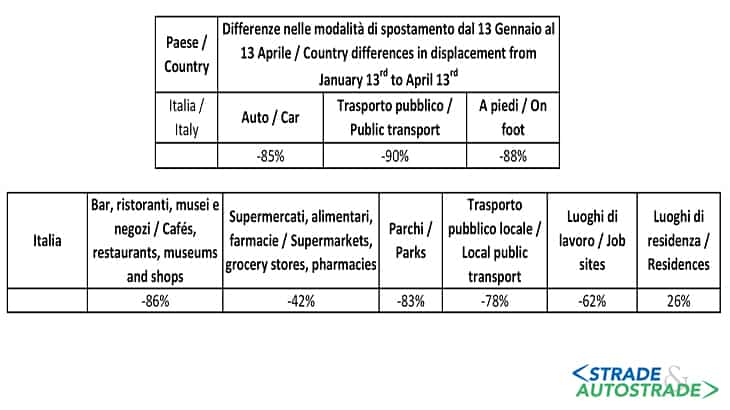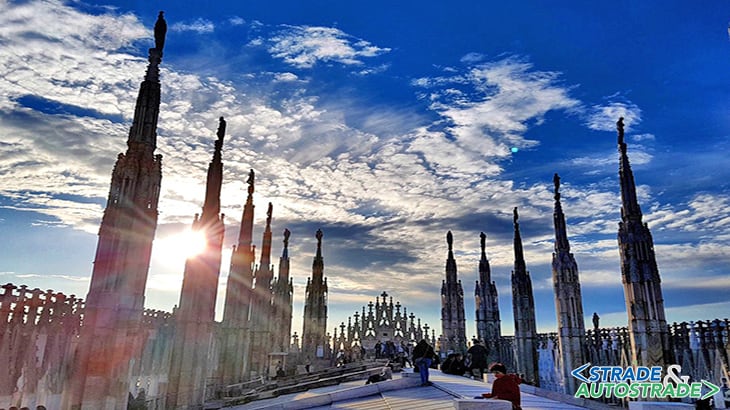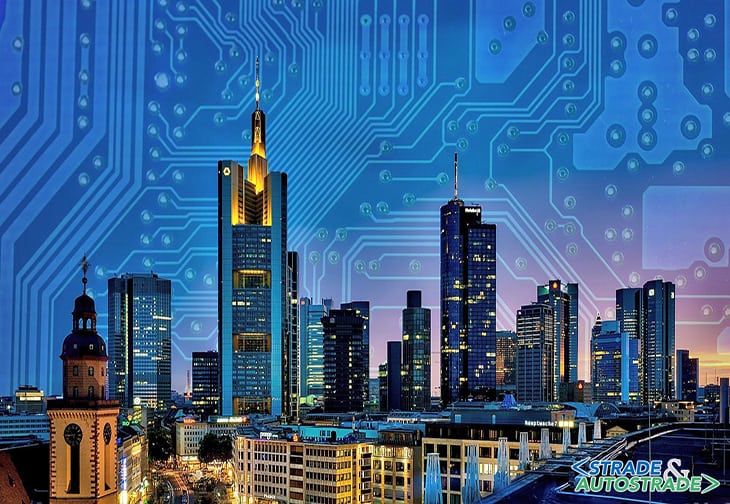A new Smart City model after Covid-19 – part 1 ![]() Per la versione in Italiano: https://www.stradeeautostrade.it/its-smart-road/un-nuovo-modello-di-smart-city-post-covid-19-prima-parte/
Per la versione in Italiano: https://www.stradeeautostrade.it/its-smart-road/un-nuovo-modello-di-smart-city-post-covid-19-prima-parte/
Part 2 of the article published on issue n. 142 July/August 2020 is online on https://www.stradeeautostrade.it/en/smart-road-digital-transformation/a-new-smart-city-model-after-covid-19-part-2/.
Covid-19 must be transformed into an (expensive) test for a new Smart City model where smart mobility takes on strategic value.
The monitoring of the various phenomena detected in the various Covid-19 phases constitutes an extremely important reference base for setting up a new methodological approach useful for structuring a new post-lockdown (smart) city model.
Such an approach must be based on the correlation between initiatives taken to stem the spread of the virus and the results obtained; essential tool to be able to deal with long-standing problems such as pollution, traffic congestion, inadequate public transport, etc. which are a direct consequence of inadequate planning decisions.
The part dealt with here mainly concerns the management of mobility and transport in the post-lockdown phase.
Considering the strategic role of these issues, “Strade & Autostrade” will keep on publishing technical details and – above all – will play the role of attentive observer of all the interventions that will have to be carried out during and after Covid-19 in order to achieve the model of a better, really smart city.
In this issue we publish the first part of this contribution, mainly dedicated to the description of the reference scenario and the framework of macro-issues.
The second part of this article, that will be publisched on issue n. 142 July/August 2020 and will be online by wednesday July 15th, will include a description of the project by the ENEA, Smart Italy Goal, which is aimed at generating specifications of standards at national level, which cities must follow in order to build – consequently – dedicated infrastructures; a description of the enabling factors that can make it feasible; because you need a real time schedule for the city and also the circular economy and the smart mobility have contributed to changing the way you move.
Actions to contain the infection have indirectly made the air of Milan, Lombardy and many areas of Italy more breathable, by providing indicators which are useful for the reorganization of our cities according to a model aimed at improving the quality of life and using results achieved with the application of security measures to contain and block Covid-19.
We believe that the measures taken to deal with Coronavirus can be a great, and involuntary, useful test to set up a new model of truly smart city.

Convinced that even from the most negative experiences it is possible to derive food for thought or real lessons, as preached by the culture of failure practiced by the most advanced companies.
The Coronavirus emergency must become a large-scale test for a less congested, less polluted, more resilient and more eco-sustainable smart city.
Now we have the opportunity to start again and without returning to the traffic and pollution of the previous era. It will not depend only on the fear of contagion but on the ability to reset our social model.
The intervention scenario
Among the various indicators available, the primary reference is air quality which is the indicator that involves: traffic (both as emissions and as the type of engine), transport and heating.
The infographics detected by ESA’s Sentinel 5P satellite say that the percentage of reduction in pollution marks a decrease (as in the case of Italy) of over 40 points. All the initiatives taken to stem the spread of the virus contribute to this result, but among these the notable decrease in mobility, both public and private, plays a primary role.
A research carried out by Moovit, the mobility-as-a-service app with over 750 million users, has investigated the issue, and has drawn a picture that can help identify the future mobility scenarios and above all how to rethink it.
The access to public transport dropped between 80 and 90%: all in all, however, the transport that includes buses, trains, underground, light rail, private transport with driver and shared mobility options such as bicycles and scooters, sees an 86% decrease in Milan, 84% in Madrid, 54% in the New York metropolitan area.
Specifically, according to some observers such as the OCPI – Observatory of public accounts of the Catholic University – by processing the data made available by Google obtained from Google Maps, and by Apple through smartphone applications, it has been possibile to show how much and in which ways mobility has decreased (modal cut) in February and March.
According to Arpa Lombardia, which monitored oxides (NO) and nitrogen dioxides (NOx) (main emission in diesel engines) in the February 1-March 26 period, their reduction due to Covid-19 measures is estimated to be between 30 and 40%. To a lesser extent is the reduction of CO2 (carbon dioxide).
A different question is represented by the components of the particulate matter (PM10 and PM2.5), which heavily contributes to city smog, for which transport is responsible, to the extent between 70% and 90% (period of normal traffic and not conditioned by the measures Covid-19); the “negative” contributions of heating systems that emit between 10% and 30% of the particulate matter in cities should not be overlooked here.

It should be highlighted that it is complex to separate the effect on mobility generated by the introduction of measures from the other factors that have led to the decrease since there is an effect on mobility that is independent of the measures adopted by Governments and depends mainly on the change in citizens’ behavior after the spread of the pandemic.
In China, the epidemic had an indirect effect: a 100 million tons cut in CO2 emissions.
The challenges after the emergency
Apart from having to satisfy a need of the moment, this emergency period therefore shows how urgent it is to adopt a broad perspective and that everyone is part of the resolution process.
Otherwise, the risk is to bring our cities back to pre-Covid-19 conditions, also losing a great opportunity. This vision will be particularly important when the recovery is planned.
Forward-looking solutions, adopted with the collaboration of several actors from different sectors and without hesitation, can represent the turning point in order to be able to reorganize our cities according to criteriaof greater liveability. As has been shown, the importance of a context capable of coping with technological innovation is evident.
This is the main challenge that the public administration will face in the phases following the current emergency. The priorities will also be of a regulatory nature and will concern various scientific, social and economic aspects.
Starting from the scenario outlined also on the basis of the assumptions highlighted, some guidelines are being defined with determination that contribute to the definition of a new path, a new approach, in planning our cities, affecting all the components that have a direct and indirect role in the reduction/containment of several aspects.
Ensuring resilience and sustainable development
According to Istat, the daily systematic mobility is 30 million inhabitants, and 50% of this moves outside of its municipality.
It is therefore necessary to set up a new mobility model within which strategic choices must be made both on LPT and on the use of the private car, the two main elements for the governance of mobility, especially the urban one.
In order to eliminate congestion, pollution, etc., the “smart city model” approach, which – yesterday – seemed to be able to positively transform the urban dimension on a global scale, but with limited results, gives today the opportunity to save the planet from the pandemic by allowing a sort of virtual sociality between people, the guarantee of being able to develop services in support of companies that otherwise would have ceased operations, similarly as a substitute element for the TPL for travel, etc..
Reviewing mobility: between intelligent mobility and Smart Road
Intelligent mobility has been a highly debated topic in recent years, being a typical sector of convergence between new needs, new technologies, new lifestyles, strong urbanization.
Today, because of the coronavirus, we have to rethink everything, radically, once again. In recent years many reflections and a lot of planning have been spent to find the best balance between mobility needs and sustainability needs. We basically talk about this when it comes to smart mobility, terminology that also echoes “Smart City”, “smart home”, “smart building”, “smart car”, etc..
Smart in all these cases stands for “intelligent”: typically, intelligence is that brought by the use of new technologies which can be the new product with innovative features or even the most intelligent management of resources through apps and platforms or the integration between these two things.

Phenomena such as car or bike sharing or electric scooters; the advent of connected, electric, even autonomous vehicles; the idea of ultra-fast trains such as Hyperloop: these are all examples that are helping to create the new intelligent transport industry, making us imagine and experiment with new ways of getting around the city, but also amongcities.
When returning to “normal” mobility management, public and private transport must first of all be accompanied by new habits, by a new education in mobility; solving the perennial question of traffic congestion which in turn produces important pollution phenomena, etc. In a city like Milan where around 500 thousand people move every day for work or study, rethinking access to public transport is a lot as crucial as urgent. Similarly for private traffic, which is the complementary part of the TPL.
These indications must then be made their own by urban planning and territorial planning, which in various cases have proved inadequate to the urban and territorial reality.
A new mobility requires new rules
As more and more digital services begin to spread in the cities, those working to regulate them struggle to apply outdated rules and outdated processes to them, and find themselves suffocated by outdated regulatory frameworks.
This phenomenon is particularly evident in relation to mobility. The Laws of the 20th century and the mechanisms for applying them are not dynamic enough, too conservative, lacking in administrative discretion, lacking the necessary data, and neither citizen-centred nor open to public feedback.
Atlanta has recently embarked on a process of modernizing its regulatory response, creating a Mobility Planning Office as a first step towards a significant response to new offerings in the transport world, who are increasingly competing for space with pedestrians and cars. But Atlanta, like other cities, finds itself caught between conflicting problems.
82% of its residents think that the current total number of over 6,200 electric scooters should be a usable option, for example, however at the same time the city suffers from a high number of accidents involving scooters, and companies are withdrawing from the market for confiscation and deposit costs.
In January, Lime announced their detachment from Atlanta, when they owed the city nearly $ 70,000 in fines for illegally parked scooters that the city had confiscated.
In the short term, Atlanta will extend permissions for scooters while working on fair rules to handle them. But although the new mobility offices like the Atlanta one will probably come up with better rules, a comprehensive reform requires something rather elusive: integrated, accessible and real-time data.
Increasingly interconnected, increasingly intelligent, increasingly flexible: city mobility is undergoing a significant evolution.
With the advent of a new era of mobility, the question arises of how it is possible – and whether it is possible – to adapt the old rules to the new systems, or whether it is necessary to devise a new regulatory approach capable of responding to their logic.
In an article published on ASH Center, the official portal of the Institute, Stephen Goldsmith (Director of the Innovations in Government Program of the Harvard Kennedy School, the Harvard School for Public Policy), offers interesting ideas.
This is declined as follows.
Flexibility, the keyword for the rules of the new mobility
Modernizing regulatory tools to allow real-time data collection would facilitate more elastic and modulated approaches. For example, how should a city respond to the conflicting objectives of regulating the use of scooters or distributing the services of private car transport companies (TNCs) such as Uber and Lyft on the territory?
He could set a cap or fine them, of course, but these are inefficient tools, especially when the seller is losing money. Real-time dynamic data from different sources (both human and machine) can show where scooters or TNCs operate and how they are used, if some services allow citizens to reach a bus stop, and where to block a sidewalk with a parked scooter or an Uber in the second row creates complaints or accidents.
To realize the benefits of these emerging mobility options, cities must also think more overall about their regulatory framework, paying attention to the needs of end users and at the same time ensuring a competitive and non-oligopolistic market.
Administrative agencies dealing with mobility, including departments responsible for roads, car parks, TNCs, traditional taxis, transit and sharing of bicycles and scooters, must not only unite on general shared objectives, but also receive more freedom from the council municipal.

The legislative process is long and inherently slow to respond. And many innovative solutions bring unknown advantages and risks, so writing legislative rules is a task full of pitfalls right from the start.
A city council should set general goals, but allow administrators to make data-driven decisions that support adjustments, to reduce traffic or encourage turnover in common spaces.
Real-time data can show where prices should be lowered due to low use, or raised for periods of high use, such as during a sporting event.
The study of possible alternatives to the different mobility modes
What can be done for those who cannot resort to home working? By what means is it possible tomove? For example, in cities with a subway network, efforts are being made to calibrate the use of vehicles according to the capacity of the docks by calculating the minimum distance between passengers waiting: approximately 1.80 m (6 feet).
Buses, trams and subways should only carry a number of passengers suitable for the vehicle and the liveability of people, staggered trips at specific times, and an indication of the availability of seatsto be given at each stop, also via app.
On car sharing, the debate becomes more complex. For the benefit of air quality, management companies must use an electric vehicle fleet. A choice that would leave the fleet of other vehicles intact, so that they can be used only at certain times or in specific areas or circumstances.
The most accredited means, however, remains the bicycle, both personal and in sharing (in this case electric scooters are also being encouraged). Finally, a massive development of technology has beenmonitored. Specific apps could represent a concrete aid for shared mobility, for real-time updates on the consistency of traffic, and the means availability.
New lifestyles and the digitalization of cities
Telecommunication infrastructures have widely demonstrated that without their intervention different activities could not have been established such as: online purchase of foodstuffs to be consumed at home, online purchases in general, long distance meetings, call conferences, smart working, distance lessons, online medical consultations, etc..
China was already moving in this direction and the virus is accelerating change. Financial analysts prophesy that smart cities have not set: on the contrary, they will experience an extraordinary new spring, because soon the “virtual contagion” will spread all over the planet, once the viral one is defeated.
In essence: transforming every possible movement into new ways that allow you to replace each physical movement with a virtual one.
As authoritative international financial analysts suggest, we must look far and study the moves of China, which first experienced the drama of the viral scourge.
After two months of epidemic impact and total blockade, which led to an abrupt setback in the economy, China is raising its head and is thinking of an even smarter future than that envisaged in the previous phase.
Smart working
There is no doubt that smart working is a solution to be encouraged. The agile work, in fact, already understandably started in the strategic logic of many companies for some years, could streamline the flow of metropolitan traffic by 20% (500 thousand employees).
People to add to the same number who already did it, albeit in different ways, often mixed. Smart working, then, allowed the continuation of several activities that would otherwise have been irreversibly compromised. And now, that the peak of the infection appears to have been overcome in different countries, what will happen?

Unlike many developed countries, China can stimulate further investments in some technological projects, such as the 5G and Smart City projects.
More generally, therefore, the long-term economic driver has remained unchanged, i.e. the continuous shift from the economy driven by exports and investments in infrastructures towards consumption and services will continue, with particular emphasis on smart transformation projects in cities, although Covid-19 could cause a profound impact on people’s lifestyle.
In fact, how would Wuhan have managed if they had not had robust digital networks in the middle of the emergency?
How to manage smart mobility in a future that requires less public transport capacity (less than 50% and over) and the development of alternative solutions?
The 60% “load factor”, referring to trains and planes, means that there will be room only for 60 passengers where previously 100 could sit. In the case of public transport, “the filling factor” is even lower.
So let’s go back to the topic of digital solutions and a holistic model that can use them to resume social activities in safety. Those who move away from public transport could discover sharing mobility, but not all of it. Instead, bikes, scooters and electric scooters could start up again.
Now more than ever mobility has to become intelligent, offering the best solution to move easily, sustainably and safely from point A to point B.
Mandatory smart mobility is the great challenge facing public administrations and private companies, because there can be no restart without movement but it is not conceivable without a collective change that treasures the experiences of the lock down.
With the numbers we have seen it is unthinkable, highlights the Confederal Transport and Services Agency (Agens), to avoid the crowds at the subway turnstiles or at bus stops in a city like Milan without the city maintaining part of its new habits, smart working for example, resuming its activities at different times and also developing alternative mobility solutions, especially for short journeys.
Turning an urban context into a smart one means implementing applications capable of solving a problem, starting from real needs of the population, companies and administrations.
For example, installing a camera on a pole is not a smart solution: on the contrary, a smart solution is making the pole capable of detecting the presence of traffic, the queue at the post or for shopping or even to intelligently monitor a parking lot.
Public lighting systems can thus become fundamental pillars not only for the growth of Italy as an innovative nation, but also to create well-being for those who live and work in the city.
Other countries, among other things, are already exploiting this enormous infrastructural potential and it would be a shame not to be able to take advantage of it as a country in Italy.
Part 2 of the article published on issue n. 142 July/August 2020 is online on https://www.stradeeautostrade.it/en/smart-road-digital-transformation/a-new-smart-city-model-after-covid-19-part-2/.
![]() Per la versione in Italiano: https://www.stradeeautostrade.it/its-smart-road/un-nuovo-modello-di-smart-city-post-covid-19-prima-parte/
Per la versione in Italiano: https://www.stradeeautostrade.it/its-smart-road/un-nuovo-modello-di-smart-city-post-covid-19-prima-parte/

